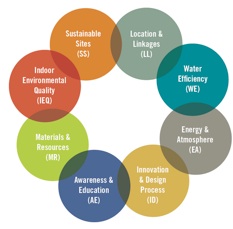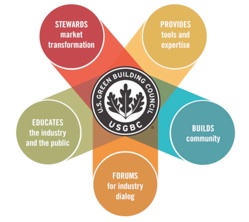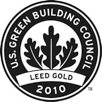LEED for Homes
-
-
-
-
LEED for Homes is whole-home green building certification program, developed by the U.S. Green Building council, that promotes the design and construction of high-performance green homes, including affordable housing, mass-production homes, and custom designs. Every LEED certified home is third party-verified and performance tested, to assure the homeowner that their home is truly green.
-
-
-
About the USGBC
The U.S. Green Building Council (USGBC) is a 501c3 non-profit organization committed to a prosperous and sustainable future for our nation through cost-efficient and energy-saving green buildings. The USGBC is the largest green building organization in the country, with a community comprising 78 local affiliates, and more than 18,000 member companies and organizations.
Verification Services
LEED Green Raters play a critical role in the LEED for Homes process by overseeing all verification services on a project. G-Build has an accredited Green Rater (first in Utah) on staff to conduct the necessary field inspections needed for certification.



Design and Building Services
As a LEED Accredited Professional (AP) for Homes, Brett understands how to successfully design and build LEED projects, and have comprehensive knowledge of the rating system. Through his experience as a LEED Green Rater, Brett understands LEED documentation, and the extensive submittal and verification process. And as the Residential Green Building Advocate for the USGBC Utah Chapter, Brett keeps current with the LEED for Homes program through monthly conference calls with national representatives.
Integrative Design- We will assist in developing a synergistic project team. Selecting the right subcontractors is critical to the success of any green project. We organize planning/design meetings and insist that the major stakeholders of the project participate in these meetings. By receiving input from the important trades, better design is achieved.
Construction Management- We can provide assistance throughout every phase of your LEED-H project-- conception, planning, design, construction, post-construction.
Program Overview- A complete overview of the LEED for Homes rating system, credit by credit.
Kick-Off Meetings- Held prior to the mandatory Preliminary Rating. These meetings are essential orientations of the LEED rating system and the requirements of the program. We will discuss performance testing, Energy Star Thermal Bypass compliance, project documentation, elective indoor air quality testing, and other appropriate optional credits.
Design Charrettes- ID Credit 1.4: “No later than the design development phase and preferably during schematic design, conduct at least one full-day integrated design workshop with the project team defined in ID 1.2. Use the workshop to integrate green strategies across all aspects of the building design, drawing on the expertise of all participants.” G-Build will organize and facilitate these design charrettes, and confirm that key issues are addressed.
Preliminary Rating- ID Prerequisite 1.1: “As early as practical, conduct a preliminary LEED for Homes meeting, with the participation of the Provider and key members of the project team.”
G-Build will organize and facilitate these mandatory meetings, confirming; the targeted LEED award level (Certified, Silver, Gold, Platinum); selected credits; and the parties accountable for meeting the prerequisites and credits.
Job Scope Development- Developing job scope for key subcontractors is also critical for high performance homes. Some materials and methods will be new to subcontractors and field personnel, and it is important that trades be informed on the scope of work up front. Doing so will reduce discrepancies in the field.
LEED Documentation- Managing the documentation associated with LEED for Homes can be challenging and time consuming. We can provide assistance with the Project Checklist, photo documentation, calculations, Accountability Forms, and other forms needed for certification.
Homeowner Manual- AE Prerequisite 1.1: An operations and maintenance manual must be provided to the homeowner. We can assist in the development of this homeowner manual by incorporating photographs taken at each stage of construction, copies of LEED documents, manufacturers’ manuals for equipment/appliances, and critical operations and maintenance guidance

Is LEED expensive?
This a very common misconception. You can blame this on a few high-end, high-profile projects. These homes have received a lot of attention from the building industry, and may be more expensive than the average new home, but they do not reflect the average costs of a LEED Home. Actually, as of June 2010, 39% of Certified LEED Homes were affordable homes (low income housing, production homes). The many reasonably priced homes certified in the program demonstrate the affordability of LEED.






G-BUILD Green Home Building
5078 Sandpiper Dr #546
Salt Lake City, Utah 84117

